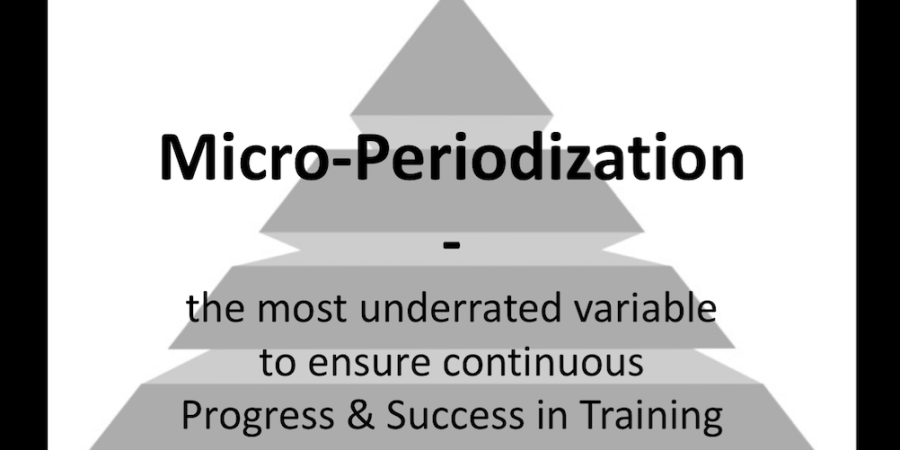
What is Micro-Periodization?
The term Periodization is generally known in Sports Science. It defines the division of training programs into individual cycles in which the individual training parameter sets, repetitions, tempo and pause – as well as exercises, frequency, total volume, average intensity and peak intensity are structured to allow constant, optimal, sustainable and maximal training progress.
Periodization is generally divided into the following four units:
Training Session (1h)
The training session is the smallest self-contained element of training in classical sports science. The training session is largely determined by training goals and training methods, which result from the requirements and goals of the training programm based on the current status and the goal of the athlete.
Microcycle (3 days to 1 week)
A Microcycle is the shortest part of the training cycle, which is regularly repeated in its basic structure and function. Elements of the Microcycle are individual training sessions. The goal of a Microcycle is derived mainly from the goal of the Mesocycle. The Deload is one of the most popular and efficient elements of the Microcycle.
Mesocycle (2 to 4 weeks)
In sports science, a Mesocycle is a medium-length training section that is repeated in its basic structure and function, which is a part of a Macrocycle consisting of several Microcycles.
Macrocycle (3 to 12 months)
A Macrocycle is a longer regular recurring training session with a similar task and basic structure in sports science. A Macrocycle can cover the period of several months up to one year.
What is Microperiodization?
In sports science, the structure of Micro-, Meso- and Macrocycles has been intensively studied for decades. However, the specific structure of total volume, average intensity and peak intensity within a training session hasn’t gotten much attention. Therefore I defined the term „Microperiodization“ a few years ago, which addresses the structuring of total volume, average intensity and peak intensity within a training session. The most crucial factor here is how to choose a weight for each set of an exercise within a training session. This has a great influence on the training effect and progress.
Example:
Option A – 8 sets of 3 repetitions. BB Benchpress. Start with a heavy set and reduce the weight from set to set (by about 2% each). Set 1 – 90kg for 3 repsSet 2 – 88kg for 3 reps
Set 3 – 86kg for 3 reps
Set 4 – 84kg for 3 reps
Set 5 – 82kg for 3 reps
Set 6 – 80kg for 3 reps
Set 7 – 78kg for 3 reps
Set 8 – 76kg for 3 reps
Total volume: 24 repetitions with a total of 1992kg
Average Intensity: 83%
Peak Intensity: 90% Option B – 8 sets of 3 repetitions. BB Benchpress. Work up to one heavy set (spread about 25%). Set 1 – 70kg for 3 reps
Set 2 – 75kg for 3 reps
Set 3 – 80kg for 3 reps
Set 4 – 85kg for 3 reps
Set 5 – 87,5kg for 3 reps
Set 6 – 90kg for 3 reps
Set 7 – 92,5kg for 3 reps
Set 8 – 95kg for 3 reps
Total volume: 24 repetitions with a total of 2025kg
Average Intensity: 84.4%
Peak Intensity: 95%
The differences between the two forms of Microperiodization are clear. The metabolic demand, the peak weight and the ability to increase the weight from one training session to the next training session are the three main differences. Theory is important, practice is importanter. I recommend everyone who reads this article to train each of these two systems with the given percentages (kg =%) for 6 training sessions each and this experience the differences themselves.
Basically, there are four different ways to structure the weight of each set of an exercise within a training session:
1. Work up to a top weight
2. Start with a heavy set and reduce the weight or reps from set to set
3. Identical weight for all sets
4. Structure the weight in a wave-like form through the workout
These four options of Microperiodisation offer various advantages and disadvantages which translate into the optimal scenarios where you use which way to optimize and maximize training progress and success.
In Module 3 of the YPSI Trainer B License during the YPSI Semi Private Internship I will discuss in detail the advantages and disadvantages as well as their use and application in the real world.
All the Best using Microperiodization for even more Progress & Success in Training!
